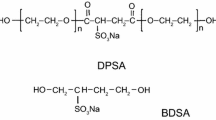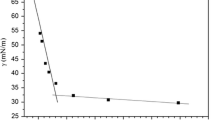Abstract
A series of ionic/nonionic polyurethane-silicone dispersions (PUSDs) with a high solid content and low viscosity were prepared using isophorone diisocyanate as the hard segment, polytetrahydrofuran polyether diol (PTMG) and polysiloxane diol (PESI) as the complex soft segments and an ionic/nonionic low molecular weight polyether diol (DPSA) as the hydrophilic, chain-extending agent. The morphologies and rheological properties of the ionic/nonionic PUSD were examined using particle-size, TEM, and viscosity analyses. The hydrophobic and mechanical properties of the dispersions were also tested. It was found that under the conditions of a constant NCO/OH ratio (2/1) and weight percentage of DPDA (6%), the PUSD dispersions with higher PESI contents possessed higher average particle diameters and wider particle-size distributions. Particles in the PUSD dispersions are generally spherical and have a typical core–shell structure due to the use of complex soft segments. However, the solid content of the ionic/nonionic PUSD increased first and then decreased as the weight ratio of PESI to PTMG increased. When the ratio ranged from 4/10 to 6/10, the max solid content of the ionic/nonionic PUSD reached up to 58%, but the viscosity of the PUSD was less than 400 mPa.s−1. Meanwhile, the water contact angle of the films increased due to the formation of a crosslinking structure on the side of the PUSD macromolecule, and when the weight ratio of PESI to PTMG varied from 3/10 to 7/10, the water contact angle of the films increased from 48.3° to 72.3°. In addition, both the freeze-thaw and thermal stabilities of the PUSD dispersions were enhanced as the weight ratio of PESI to PTMG increased. The PUSD coating had good mechanical properties as well.







Similar content being viewed by others
References
Kim, B, “Aqueous Polyurethane Dispersions.” Colloid Polym., 274 599–611 (1996)
Noble, K-L, “Waterborne Polyurethanes.” Prog. Org. Coat., 32 131–136 (1997)
Rahman, MM, Kim, HD, Lee, WK, “Properties of Waterborne Polyurethane Adhesives: Effect of Chain Extender and Polyol Content.” J. Adhes. Sci. Technol., 23 177–193 (2009)
Yen, MS, Tsai, PY, Hong, PD, “The Solution Properties and Membrane Properties of Polydimethylsiloxane Waterborne Polyurethane Blended with the Waterborne Polyurethanes of Various Kinds of Soft Segments.” Colloids Surf. A Physicochem. Eng. Asp., 279 1–9 (2006)
Du, H, Zhao, Y, Li, Q, Wang, J, Kang, M, Wang, X, Xiang, H, “Synthesis and Characterization of Waterborne Polyurethane Adhesive from MDI and HDI.” J. Appl. Polym, 110 1396–1402 (2008)
Madbouly, SA, Xia, Y, Kessler, MR, “Rheological Behavior of Environmentally Friendly Castor Oil-Based Waterborne Polyurethane Dispersions.” Macromolecules, 46 4606–4616 (2013)
Cakić, SM, Ristić, IS, Milena, M, Stojiljković, DT, Jaroslava, B, “Preparation and Characterization of Waterborne Polyurethane/Silica Hybrid Dispersions from Castor Oil Polyols Obtained by Glycolysis Poly (Ethylene Terephthalate) Waste.” Int. J. Adhes. Adhes., 70 329–341 (2016)
Rahman, MM, Kim, HD, “Synthesis and Characterization of Waterborne Polyurethane Adhesives Containing Different Amount of Ionic Groups (I).” J. Appl. Polym., 102 5684–5691 (2006)
Park, SH, Chung, ID, Hartwig, A, Kim, BK, “Hydrolytic Stability and Physical Properties of Waterborne Polyurethane Based on Hydrolytically Stable Polyol.” Colloids Surf. A, 305 126–131 (2007)
Wang, L, Shen, Y, Lai, X, Li, Z, Liu, M, “Synthesis and Properties of Crosslinked Waterborne Polyurethane.” J. Polym. Res, 18 469–476 (2011)
Sardon, H, Irusta, L, Fernández-Berridi, MJ, Lansalot, M, Bourgeat-Lami, E, “Synthesis of Room Temperature Self-Curable Waterborne Hybrid Polyurethanes Functionalized with (3-Aminopropyl) Triethoxysilane (APTES).” Polymer, 51 5051–5057 (2010)
Rahman, MM, Kim, H-D, Lee, W-K, “Properties of Crosslinked Waterborne Polyurethane Adhesives with Modified Melamine: Effect of Curing Time, Temperature, and HMMM Content.” Fibers Polym., 10 6–13 (2009)
Udagama, R, Degrandi-Contraires, E, Creton, C, Graillat, C, McKenna, TF, Bourgeat-Lami, E, “Synthesis of Acrylic–Polyurethane Hybrid Latexes by Miniemulsion Polymerization and Their Pressure-Sensitive Adhesive Applications.” Macromolecules, 44 2632–2642 (2011)
Park, DH, Oh, JK, Kim, SB, Kim, WN, “Synthesis and Characterization of Sulfonated Polyol-Based Waterborne Polyurethane–Polyacrylate Hybrid Emulsions.” Macromol. Res, 21 1247–1253 (2013)
Guyot, A, Chu, F, Schneider, M, Graillat, C, McKenna, T, “High-Solid-Content Latexes.” Prog. Polym., 27 1573–1615 (2002)
Kang, YS, Kim, BK, “High Solid and High Performance UV Cured Waterborne Polyurethanes.” Colloids Surf. A, 10 58–63 (2010)
Lee, HT, Wu, SY, “Effect of Sulfonated Polyol on the Properties of the Resultant Aqueous Polyurethane Dispersions.” Colloid Surface A, 276 176–185 (2006)
Wei, XL, Zhang, FX, Xiao, ZL, “Preparation and Property Study of High-Solid-Content and Low Viscosity Polyurethane Microemulsion.” J. Appl. Polym. Sci., 5 1–7 (2012)
Zhao, C, Li, X, “Synthesis of High Solid Content (ST/BA/AA) Emulsion, Particle Size and Its Distribution.” Polym. Mater. Sci. Eng., 21 118–124 (2005)
Rahman, MM, Yoo, HJ, Chung, JM, Han, DK, “Synthesis and Characterization of a Clay/Waterborne Polyurethane/Clay Nanocomposite-Effect on Adhesive Strength.” Macromol. Symp., 250 251–257 (2007)
Kuan, H-c, Chuang, W-p, Ma, C-c, “Synthesis and Characterization of a Clay/Waterborne Polyurethane Nano-Composite.” J. Mater. Sci., 40 179–185 (2005)
Lee, D, Lee, S-H, Kim, S, “Micro-Phase-Separation Behavior of Amphiphilic Polyurethanes Involving Poly(Ethylene Oxide) and Poly(Tetramethylene Oxide).” J. Polym. Sci., 41 2365–2374 (2003)
Acknowledgments
This work was partially supported by the Chemical Additives and Surfactants Key Laboratory of Sichuan Universities (Projects 2015JXY02, 2014JXY04), the Sichuan University Talents Project (Projects 2014RC14, 2015RC55), and the Sichuan Province Department of Education (Project 16ZB0254). The authors also thank all project team members for performance testing of the products in this study.
Author information
Authors and Affiliations
Corresponding author
Rights and permissions
About this article
Cite this article
Wei, X., Zhang, F. Preparation of an ionic/nonionic polyurethane-silicone dispersion (PUSD) with a high solid content and low viscosity using complex soft segments. J Coat Technol Res 15, 1229–1237 (2018). https://doi.org/10.1007/s11998-018-0063-6
Published:
Issue Date:
DOI: https://doi.org/10.1007/s11998-018-0063-6




